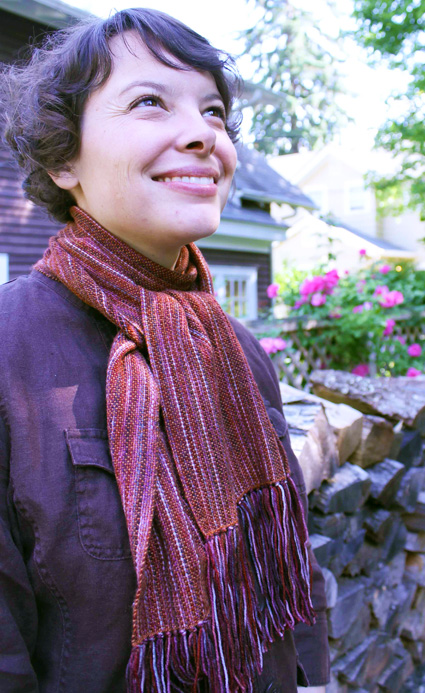

|
|
||
 by Liz Gipson
Sock yarn is such a draw for weavers. It is available in high-yardage put-ups and comes in gorgeous variegated and self-striping colorways. Most sock yarns are made with either superwash wool or nylon for added wear. These yarns are designed to stretch, but keep their shape in the wash. They don't full or shrink. This poses some challenges for weavers.
|
||
|
|
||
|
SIZE |
|
FINISHED MEASUREMENTS (laid flat) |
|
MATERIALS Project specifications
|
|
PATTERN NOTES |
|
Deciding Your Sett You are aiming for a warp dominant cloth — more visible warp than weft in the final cloth. Yarn wants to bend in the direction where the majority of the yarn is oriented. If you have more warp than weft in the cloth, it will drape in that direction. (See Yarnworker's Terms if you need to freshen up on the language of the loom). In the photo below, you can see how much the yarn changes on and off the loom. The fabric on the loom is translucent while the fabric off the loom is not. Color will shift the look of your variegated yarn a lot. The pumpkin color shifted the purples to rust, giving the sunset on mesas effect I was looking for. I experimented with other colors before I settled on this one.
|
| SETUP Warping Warp the loom following the project specs. Center the warp in the rigid heddle for 10". For the direct warping method, thread 10'' worth of slots. (Warping loom video refresher here.) Wind the warp on the back beam adding packing paper between the layers. Move one thread in each slot to a hole to its left. Tie the warp on the front apron rod and adjust for even tension. |
|
DIRECTIONS Start by weaving about 1'' of scrap yarn to spread the warp evenly. It doesn't matter if you start in an up or down shed. Using your project weft, open the next shed and insert your first pick, leaving a short tail of about 6". Change sheds, tuck the tail in the new shed and then bring it out between two warp ends. Continuing weaving, maintaining the weft angle as you go. This allows the weft enough room to travel over and under the warp ends and keep your fabric from pulling in at the edges. If you have loops at the edges your weft angle is too steep. Beat the yarn gently as you weave to maintain a consistent number of picks per inch. WeavingWind 2 shuttles, one with a smooth scrap yarn, and the other with your weft yarn. To give yourself a good foundation and to spread the warp, start by weaving a piece about 1.5 inches long with scrap yarn. It doesn't matter if you start in an up or down shed. Using your project weft, open the next shed and insert your first pick leaving a tail of about 6 inches. Change sheds, tuck the tail in the new shed and then bring it out between two warp ends. Lay in the next pick at about a 60 degree angle and beat (see top photo at right). Continuing weaving, as you do maintain your weft angle. This will allow the weft enough room to travel over and under the warp ends and keep your fabric from pulling in at the edges. If you have loops at the edges, called selvedges, your weft angle is too steep, Beat the yarn gently as you weave to maintain a consistent number of wefts per inch. (See middle photo.) Your goal is to get the same number of warp and weft ends in an inch of weaving. Don't over think this, though. The goal is to get a few projects under your belt, not perfection! FINISHING Remove the scarf from the loom by cutting the warp behind the rigid heddle and untying the warp from the front apron rods. Using small embroidery scissors and working carefully, cut the scrap yarn in half. Remove half of the scarp and tie the warp in bundles of four warp ends using an overhand knot. Using a 1/8 cup of mild detergent, machine wash on gentle cycle in warm water. Trim fringe to desired length. |
| ABOUT THE DESIGNER |
Liz Gipson is a lover of yarn and that from which it comes — namely the mills and fiber-bearing critters and plants. She is the author of the newly revised Weaving Made Easy and has two DVDs Slots and Holes: Three Ways to Warp a Rigid-Heddle Loom and Life After Warping: Weaving Well on your Rigid-Heddle Loom She recently lanched Yarnworker, a source for indepentantly published patterns and know-how for the rigid-heddle loom. |
Text & images © 2015 Liz Gipson. Contact Liz |